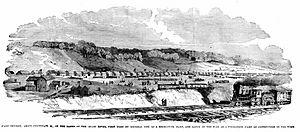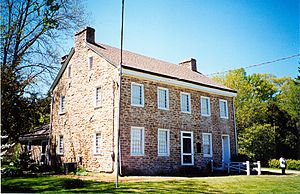Camp Dennison facts for kids
Quick facts for kids Camp Dennison |
|
|---|---|
| Camp Dennison, Ohio, near Cincinnati |
|

Camp Dennison
|
|
| Type | Military recruiting and training post |
| Site information | |
| Controlled by | |
| Site history | |
| Built | 1861 |
| In use | 1861-1865 |
|
Waldschmidt-Camp Dennison District
|
|
| Location | 7509 and 7567 Glendale-Milford Rd., Symmes Township, Hamilton County, Ohio, near Cincinnati, Ohio |
|---|---|
| Area | less than one acre |
| Built | 1804 |
| NRHP reference No. | 73001471 |
| Added to NRHP | March 07, 1973 |
Camp Dennison was an important place during the American Civil War. It was a military camp where soldiers joined the United States Army and learned how to be fighters. It also had a hospital to care for sick and injured soldiers. The camp was near Cincinnati, Ohio, close to the Ohio River. It was named after William Dennison, who was Ohio's governor when the war began.
Contents
Why Camp Dennison Was Built
When the Civil War started in 1861, Ohio's governor, William Dennison, needed a place to train soldiers. He asked George B. McClellan, who led Ohio's state army (called the militia), to find a good spot. Southern Ohio was a possible target for the Confederate States Army (the southern states fighting against the Union). This was because of its location near the Ohio River and close to states like Kentucky and Virginia, where slavery was allowed. These states could launch attacks.
Choosing the Location
Captain William S. Rosecrans chose the exact spot for the camp. He picked a flat piece of land near Indian Hill, Ohio, about 17 miles (27 km) from Cincinnati. This land was on both sides of the Little Miami Railroad tracks. The railroad was important because it could bring new soldiers and supplies to the camp. It could also quickly move troops into Cincinnati if the city was in danger.
The camp rented about 700 acres (2.8 km²) of land from local families. The first leader of Camp Dennison was Melancthon Smith Wade. He was a former general in the Ohio Militia.
Life at Camp Dennison
More than 50,000 Union soldiers came through Camp Dennison. They either joined the army there or left the army from there. Sometimes, as many as 12,000 soldiers were at the camp at one time.
Early Challenges
Life at the camp was tough at first. The weather was cold and rainy, turning the fields into thick mud. Soldiers did not have proper buildings yet. The camp hospital was set up in a barn. Horses were moved out, and fresh straw was put down for the sick. Many soldiers got sick with pneumonia or measles. The hospital was very basic at first, with little bedding.
Responding to Threats
Camp Dennison soldiers were ready to defend Ohio. In 1862, Cincinnati was briefly threatened by Confederate cavalry. In 1863, during Morgan's Raid, Confederate cavalry led by Brig. Gen. John Hunt Morgan invaded Ohio. Troops from Camp Dennison quickly responded to this invasion.
Camp Dennison Hospital
As the war continued, a proper military hospital was built at Camp Dennison. This happened after the Battle of Shiloh. The hospital had over 200 beds in wooden buildings. These buildings were first used for soldiers, but then became hospital wards. Many more soldiers were treated there throughout the war.
Cemetery for Soldiers
A nearby place called Waldschmidt Cemetery was used as a temporary burial site. It held the graves of 340 Union soldiers and 31 Confederate soldiers. The Confederate soldiers were prisoners of war. Later, in the late 1860s, these bodies were moved to other cemeteries. They were reburied at Spring Grove Cemetery or at Camp Chase in Columbus.
The End of the Camp
The Civil War ended in 1865. Because of this, Camp Dennison was no longer needed. It closed down in September of that year. A small town, also called Camp Dennison, grew up around the old camp and hospital. Many of the buildings in the new town were built using wood and materials from the abandoned army camp.
In 1973, two buildings that were left from the camp were added to the National Register of Historic Places. This means they are important historical sites. They are part of what is called the "Waldschmidt-Camp Dennison District."
Images for kids







